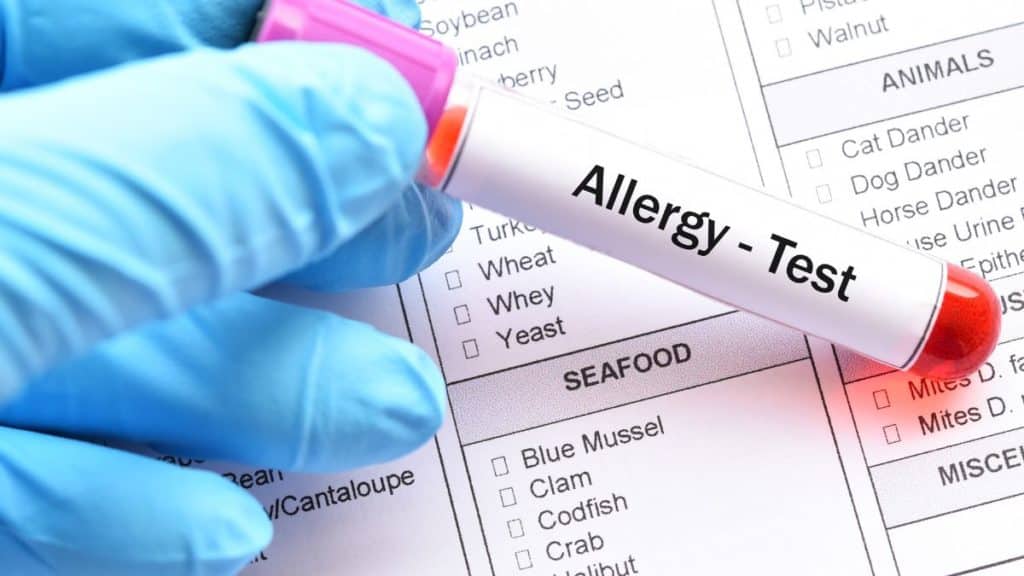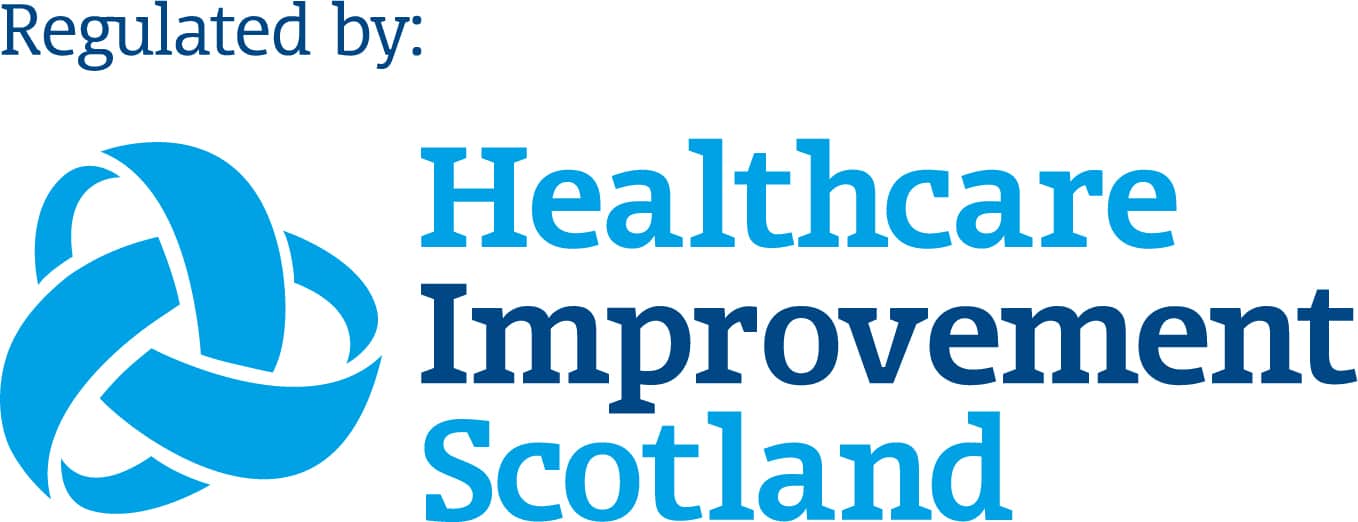
Initially, a detailed history is taken about allergic symptoms, other illnesses, the environment and possible triggers, to give the doctor an understanding of your situation and to guide the testing to follow. The doctor is also happy to review letters/results from other sources.
If necessary, a physical examination can take place, in particular assessing the lungs and skin.
Types of Allergy Tests: Which One is Right for You?
When most people think about allergic reactions, they are thinking about anaphylaxis / hayfever / hives / food allergies which are all Type 1 hypersensitivity or IgE-mediated allergy. They all occur very quickly after exposure to the cause.
IgE stands for Immunoglobulin E and is a type of antibody that is made within the airways, digestive tract and skin to a perceived threat. These IgE attach to certain types of white cell causing release of a number of substances including histamine, which cause an allergic reaction in those organs e.g. breathing difficulties, lips/tongue swelling and hives etc.
There are 2 scientifically validated allergy tests to investigate Type 1 / IgE-mediated allergic symptoms – Skin Prick Test (SPT) and blood testing for specific IgE antibodies (previously called RAST testing) which will be discussed in more detail later.
Dermatitis/eczema describes a type of inflammation of the skin. Dermatitis and eczema mean the same thing. Contact dermatitis describes inflammation that is caused by direct skin contact with something in your environment. Patch testing can be performed on anyone with troublesome eczema/dermatitis that doesn’t respond to the usual medications. It is often used for hand dermatitis where an occupational cause needs to be excluded. Contact dermatitis is a delayed Type 4 hypersensitivity. Patch testing will be discussed in more detail later.
Understanding Skin Prick Testing for Immediate Allergies
By introducing allergens into the surface layer of the skin (via a lancet so not a needle) where they can be ‘seen’ by the immune system, we can tell whether someone is allergic to that allergen if they produce a short-lasting inflammatory response which looks like a raised yellowish skin wheal surrounded by red skin. This reaction develops within 15 minutes and usually fades after an hour.
SPT can not be performed on areas of active skin disease, nor should it be done in pregnancy. Anti-histamine tablets and certain other medications block the response that this test looks for, and therefore you should discuss any medications with the clinic before your appointment, to advise of stopping some of your medications or alternative testing options.
Between the patient and doctor, it is decided which allergen vials (up to 20) are appropriate for testing from our stocks of over 120 airborne / foods / animal allergens.
Each skin prick test requires a positive and negative control to ensure accuracy. The positive control is pure histamine and a response (wheal of 4-5mm diameter) is expected – if no response then it is likely that an anti-histamine medication was used recently and makes the test invalid. The negative control is salt water and no response is expected – if there is a response then it is likely that there is an underlying skin condition such as dermatographism and makes the test invalid.
The forearm is the usual site for testing and it is marked with pen so the doctor knows which allergen was put where.
Resting the arm against the edge of a table, a droplet from each vial is placed on the skin until all are done. Then a single-use short lancet is pressed onto the skin over 1 droplet and discarded immediately. This is done to all the allergen droplets. The skin is then dried with blotting tissue and the patient is required to wait 15 minutes until the doctor can read the results. During this time, the arm will become prickly and itchy with any positives but you must not scratch it otherwise this will affect the results.
A wheal of 3mm or greater in diameter is considered significant. Unfortunately the size of the wheal does not relate to the severity of the allergic response, it just shows whether you are sensitised to the allergen or not.
The results and any recommendations/prescriptions will be discussed with you within the same hour-long allergy consultation.
IgE (RAST) Blood Testing: A Detailed Guide
This is a simple blood test that the doctor will draw from you at the end of your consultation. There are various different allergic profiles that can be chosen dependant on what type of allergen might be causing your symptoms. For example:
- Rhinitis Provoking Profile (all the different causes of a persistent runny sneezy nose)
- Inhalant Profile (all the commonest inhaled allergens in the UK)
- Nuts and Seeds Profile
- Insects Profile (i.e. bee and wasp sting allergy)
We use The Doctors Laboratory (TDL) for our allergy testing which is a quality assured laboratory in London. The results are usually back within 3 days, and dependent on how you have requested to receive your results, the results will either be discussed with you during your follow-up appointment, or emailed to you in a detailed report including any recommendations/prescription suggestions.
There is also Allergen Component testing. IgE testing as described above looks at antibodies in your blood against whole allergens e.g. milk / egg / cat / grass pollen. But all of these things are made up of more than 1 protein (or component) – some of which you can be allergic to and others not. This can determine on a molecular level what components within a whole allergen you are allergic to and is becoming increasingly used to predict the severity of future reactions. We use the ‘Allergy Explorer’ or ALEX test which tests for 282 components from 157 preselected allergen sources, through the Bio-Diagnostics laboratory in Worcestershire. The results are usually back within 10 days and dependent on how you have requested to receive your results, the results will either be discussed with you during your follow-up appointment, or emailed to you in a detailed report including any recommendations/ prescription suggestions.
Choosing Between Skin Prick Testing and Blood Testing
For Skin Prick Testing
- Each prick is a minor scratch, with an itch if you get a positive reaction
- The results are quick and can be read within 15 minutes
- The results are clearly visible and hence reinforce avoidance of the cause
- If you think a certain fresh food is causing your allergies, you can bring in the food to be tested on the day with all the other clinic skin prick allergens.
- Generally a ‘one-stop-shop’ appointment with our private GP at a competitive price
Against Skin Prick Testing
- If you are unable to stop certain medications that interfere with these results
- If you have widespread skin disease e.g. eczema on the testing sites (forearm/back)
- If you have had a severe allergic reaction in the past requiring an Epipen
- If you are unable to sit still for 10 minutes for the allergen application and testing
- In one appointment, we can only test for max 18 allergens at a time, so some unusual causes of allergy might be missed
For Blood Testing
- One blood test rather than multiple skin pricks
- Can be taken from patients with severe reactions as there is no risk of causing that reaction like with skin prick testing
- It can be done if there is widespread skin disease
- There are thousands of allergens available
- It can be done if a patient is on certain medications that prevent skin prick testing to be carried out
Against Blood Testing
- The costs are much higher as these have to take in to account the consultation, the laboratory costs, the results analysis and feed back etc so is not a ‘one-stop-shop’
- Blood taking is more invasive than skin prick testing
- Results can take 1-2 weeks
- Some positive results signify sensitisation to an allergen, not an outward allergy which can be difficult to interpret, which is why these tests should never be taken by people themselves without a doctor’s involvement.
Patch Testing for Delayed Allergic Reactions
Patch testing is a provocation test whereby chemicals are applied directly on to the surface of the skin and if any of the patient’s skin symptoms flare up with certain chemicals, it confirms contact dermatitis and requires meticulous avoidance of those chemicals in future.
Common chemical causes of contact dermatitis include garden fungicides, cosmetics, medicated creams, nickel jewellery, buckles, clasps, door handles; hair dyes, leather tanning, bleach etc.
Patch testing involves 3 appointments over a week and we use a pre-determined allergen set of 35 chemicals across 3 sticky panels called T.R.U.E.TEST that are applied to the back and kept on for 2 days.
The patient comes back to clinic 2 days after application when the 3 sticky panels are removed and the first reading is taken.
The patient comes back to clinic 2 days after removal and a final result is read (as some reactions can take 4-5 days to become apparent). Reactions are measured on a scale of 1 to 3; 1 being a weak positive reaction with a corresponding redness to the skin in contact with the chemical. 2 being a strong positive reaction which is redness and skin bumps to the area in contact with the chemical. 3 being an extreme positive reaction where a blister may have formed in the part of the skin in contact with the allergen.
If there are any positive reactions on the final appointment reading, the doctor will explain the results to you and give you advice and leaflets on how to avoid these chemicals at home and in work.
Food Intolerance vs. Food Allergy: Key Differences
There are a number of possible reactions to food, which may be termed “food intolerances”. These are not immune-system based and they are much more common than food allergies. There is a delay in the reaction from up to 3 days after eating the offending foods, and symptoms are generally less serious and often limited to digestive problems.
If you have a food intolerance, you may be able to eat small amounts of the offending food without trouble. You may also be able to prevent a reaction with enzyme supplements or protein-altered foods e.g. lactose-free milk.
Causes of food intolerance include:
- Absence of an enzyme needed to fully digest a food. E.g. Lactose intolerance
- Irritable bowel syndrome leading to cramping, constipation and diarrhoea.
- Sensitivity to food additives. E.g. sulfites in preserved dried fruit,
- Coeliac disease – a digestive condition triggered by eating gluten
The doctor will be able to help guide you on whether your symptoms are likely to be allergic or intolerant in nature and what tests (if any) are required.
Unproven Allergy Tests: What to Avoid
Food intolerance testing and screening is particularly popular among alternative practitioners, and several can be found on the high street or through the internet e.g.
- Iridology
- Electrodermal Testing (Vega)
- Allergen-specific IgG4 antibody testing
- Cytotoxic testing
- The K-Test
- Hair analysis
At present, there are no reliable and validated clinical tests for the diagnosis of food intolerance, plus there are nutritional risks from unnecessary food avoidance depending on results of the above tests, and for that reason ROC Clinic does not offer any of these unregulated tests.
If you would like to book with our allergy specialist GP in Aberdeen, then please, Get in touch.



One Response
I found it interesting when you said how a physical examination can be performed if necessary, with a focus on the skin and lungs. This will be helpful for my cousin who had an allergic reaction to a food she just recently tasted. She must take an allergy test to ensure the cause of her condition.